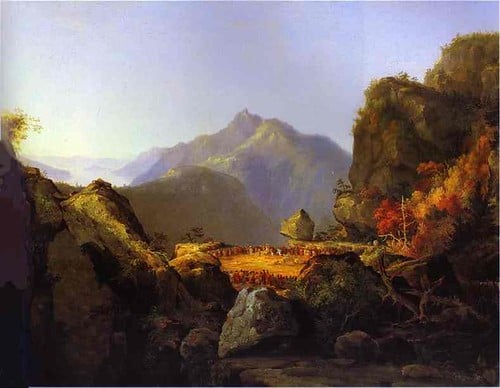Introduction
James Fenimore Cooper’s novel, “The Last of the Mohicans,” is a captivating tale set during the French and Indian War in the wilderness of colonial America. This article delves into the various aspects of the novel, including its plot, characters, themes, writing style, setting, historical context, and impact on literature.
Plot and Storyline
The film “The Last of the Mohicans” follows Hawkeye (Nathaniel Bumppo), a white man who was born into the Mohican tribe, and his companions as they travel the perilous frontier. The novel explores the conflict between various factions, including the French, British, and Native American tribes. Hawkeye, along with his Mohican friends Chingachgook and Uncas, becomes entangled in the war while protecting Cora and Alice Munro, the daughters of a British officer. The story unfolds through a series of perilous encounters, battles, and unexpected alliances, leading to a dramatic climax. Cooper skillfully weaves together adventure, romance, and themes of honor, loyalty, and sacrifice.
Characters
Cooper presents a diverse cast of characters who contribute to the richness of the story. Hawkeye, the protagonist, is a complex figure torn between his European heritage and his adopted Native American culture. His steadfastness, resourcefulness, and deep understanding of the wilderness make him a compelling character. Chingachgook and Uncas, the last of the Mohicans, embody noble qualities and serve as symbols of a vanishing way of life. The Munro sisters, Cora and Alice, exhibit strength and resilience amidst the harsh realities of the frontier. The antagonist, Magua, a cunning and vengeful Huron warrior, adds depth to the conflict. Cooper masterfully develops these characters, highlighting their motivations, relationships, and internal struggles.
Themes and Symbols
“The Last of the Mohicans” explores several significant themes. One prominent theme is the clash of cultures, as represented by the European settlers and the Native American tribes. Cooper examines the complexities of cultural identity, the impact of colonialism, and the tragic consequences of misunderstandings and prejudice. Another theme is the fragility of civilization in the wilderness. The novel’s symbols, such as the untamed frontier, the fort, and the Mohican tribe, represent opposing forces and the struggle for survival. Cooper also delves into the themes of honor, loyalty, and the power of nature, which contribute to the overall message of the story.
Writing Style
Cooper’s writing style is characterized by vivid descriptions, poetic language, and a meticulous attention to detail. He employs long, descriptive passages to create a sense of place and atmosphere. His use of figurative language and metaphors enhances the reader’s understanding of the characters and their surroundings. However, some critics argue that Cooper’s prose can be verbose and overly sentimental at times, which may slow the narrative’s pace. Nevertheless, his ability to evoke emotions and immerse readers in the world of the novel remains a testament to his skill as a writer.
Setting and Atmosphere
The setting of “The Last of the Mohicans” plays a crucial role in establishing the novel’s tone and mood. Cooper vividly portrays the untamed wilderness of the American frontier, with its dense forests, treacherous mountains, and unpredictable weather. The natural landscape serves as a powerful backdrop for the characters’ struggles and the unfolding events. The harshness and beauty of the setting contribute to the story’s atmosphere of danger, adventure, and the sublime. Additionally, the cultural and historical context of the novel, set during the French and Indian War, adds depth and authenticity to the narrative.
Historical, Social, or Political Context
“The Last of the Mohicans” reflects the historical, social, and political context of its time. Cooper wrote the novel in the early 19th century, when the United States was still a young nation grappling with its identity. The novel explores the tensions between European settlers and Native American tribes, reflecting the conflicts that arose during westward expansion. Cooper also touches upon issues of race, gender, and the impact of war on society. By incorporating these elements, Cooper sheds light on the complexities of the era and raises questions about the consequences of colonization.
Impact and Reception
“The Last of the Mohicans” has had a profound impact on literature and popular culture. It is considered one of the first great American novels, showcasing a distinctively American setting and themes. The novel’s adventurous spirit, memorable characters, and exploration of identity have resonated with readers for generations. Critics have praised Cooper’s ability to capture the beauty and dangers of the American wilderness. While the novel received mixed reviews upon its initial publication, it has since gained widespread recognition and has been adapted into several films, further cementing its cultural significance.
What is the significance of the title “The Last of the Mohicans” in James Fenimore Cooper’s novel?
The title “The Last of the Mohicans” refers to the main characters Chingachgook and his son, Uncas, who are the last surviving members of the Mohican tribe. The title symbolizes the decline and impending extinction of Native American cultures in the face of European colonization. It highlights the theme of loss and serves as a reminder of the devastating impact of cultural clashes and the encroachment of settlers on indigenous communities.
How does “The Last of the Mohicans” reflect the historical context of the French and Indian War?
“The Last of the Mohicans” is set during the French and Indian War, a conflict between the European powers of Britain and France for control of the North American colonies. The novel reflects the historical context by depicting the tensions and alliances between different factions, including the French, British, and Native American tribes. Cooper explores the complexities of the war, the struggles faced by both sides, and the impact of the conflict on individuals and communities. The novel offers insights into the historical events, social dynamics, and the consequences of the war, providing a glimpse into the historical realities of the time.
How does the novel depict the challenges faced by individuals and societies in navigating the untamed frontier?
In “The Last of the Mohicans,” James Fenimore Cooper vividly depicts the challenges faced by individuals and societies in navigating the untamed frontier of colonial America. The novel portrays the wilderness as a harsh and unforgiving environment, presenting numerous obstacles that characters must overcome.
Firstly, the physical landscape itself poses significant challenges. The dense forests, treacherous mountains, and unpredictable weather make travel and exploration arduous and dangerous. Characters must navigate through dense underbrush, cross treacherous rivers, and endure extreme weather conditions. The wilderness is portrayed as a place of both beauty and danger, where survival depends on adaptability, resourcefulness, and knowledge of the land.
Secondly, the frontier is inhabited by various Native American tribes, each with their own customs, languages, and allegiances. The novel explores the complexities of relations between the European settlers and the Native Americans, highlighting the cultural clashes, misunderstandings, and conflicts that arise. The characters must navigate this intricate web of alliances and rivalries, often finding themselves caught in the middle of larger geopolitical struggles between European powers and Native American tribes.
Additionally, the absence of established institutions and law enforcement in the wilderness creates a sense of lawlessness and uncertainty. Characters must rely on their own wits and strength to protect themselves and their loved ones. The lack of a centralized authority and the presence of opportunistic individuals further contribute to the challenges faced by individuals and societies.
Furthermore, the scarcity of resources, such as food and shelter, adds to the difficulties of survival in the frontier. Characters must forage for food, hunt for sustenance, and find secure places to rest amidst the vast and unpredictable wilderness.
Through these depictions, Cooper underscores the immense challenges faced by individuals and societies on the untamed frontier. The novel emphasizes the need for resilience, adaptability, and the ability to form alliances and friendships across cultural boundaries. It also highlights the fragile nature of civilization in such an environment, where the veneer of societal order can easily erode in the face of natural and human challenges.
Overall, “The Last of the Mohicans” paints a vivid picture of the challenges individuals and societies face when confronted with the untamed frontier. The novel explores the physical, cultural, and social obstacles that must be overcome in order to survive and thrive in the wilderness, providing a realistic and nuanced portrayal of the struggles inherent in navigating such a harsh and unpredictable environment.
Final Conclusions
“The Last of the Mohicans” is a timeless classic that continues to captivate readers with its thrilling plot, well-developed characters, and explorationof complex themes. James Fenimore Cooper’s masterful storytelling, rich descriptions, and examination of cultural clashes and the consequences of colonization make this novel a significant contribution to American literature. Its enduring popularity and cultural impact solidify its place as a beloved work of fiction that continues to resonate with readers today. “The Last of the Mohicans” stands as a testament to the power of storytelling and the exploration of universal human experiences within the context of a specific time and place.
Sources
The Last of the Mohicans – Wikipedia
The Last of the Mohicans: Study Guide | SparkNotes
The Last of the Mohicans | Introduction & Summary | Britannica






